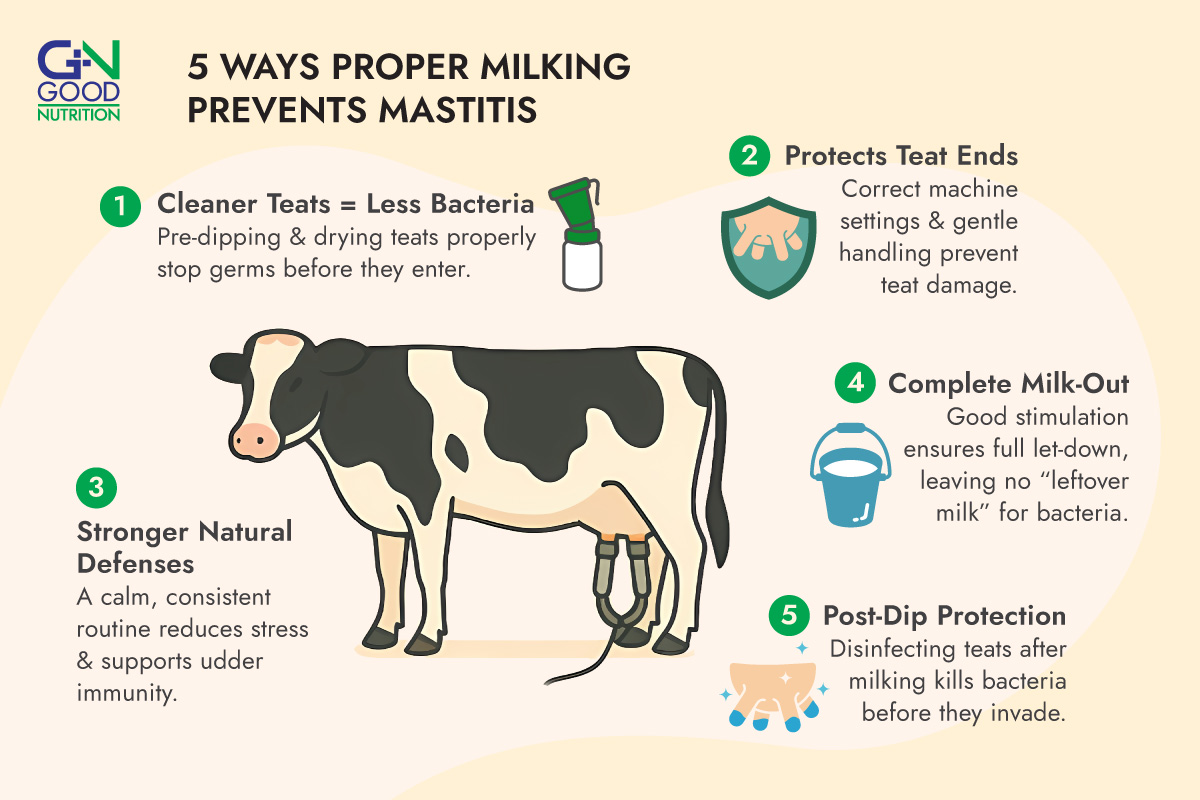Mastitis remains one of the most common and costly diseases in dairy production. It not only reduces milk yield but also affects cow welfare and increases veterinary expenses. While nutrition and housing are important in prevention, milking practices are one of the most direct and effective ways to control mastitis. Proper milking reduces bacterial entry, protects the udder, and supports the cow’s natural immunity.
- Reduces Bacterial Entry
The teat canal is the main entry point for pathogens such as Staphylococcus aureus, Streptococcus agalactiae, and E. coli. Keeping teats clean before milking is essential. Pre-dipping in disinfectant and drying teats with individual towels significantly reduces bacterial load. Milkers should also avoid dirty hands or cloths to minimize contamination.
- Prevents Teat-End Damage
Mechanical or physical damage to teat ends increases the risk of infection. Over-milking, incorrect vacuum pressure, or poorly maintained machines can cause cracks or rough teat surfaces. These small injuries prevent the teat canal from sealing properly after milking, creating a pathway for bacteria. Correct machine settings, regular equipment checks, and timely removal of clusters help maintain healthy teat ends.
- Maintains Teat Sphincter Function
After milking, the teat sphincter remains open for 30 minutes to 2 hours. During this time, cows are more vulnerable to bacteria from bedding, manure, or the environment. Gentle handling and well-functioning equipment reduce unnecessary damage and allow the sphincter to close more quickly, lowering the risk of new infections.
- Supports Udder Immunity
Stress has a direct effect on a cow’s immune system. Painful or inconsistent milking raises cortisol levels, which weakens the natural defense response. A calm, consistent routine not only improves cow comfort but also enhances the udder’s ability to fight off bacteria. This highlights the importance of proper training for milkers and maintaining a low-stress milking environment.
- Optimizes Milk Flow
Good preparation before attaching the machine is critical. Forestripping and udder massage stimulate oxytocin release, which ensures complete milk let-down. Incomplete milking leaves residual milk in the udder, and this leftover milk provides an ideal environment for bacterial growth. Proper stimulation and efficient milking routines reduce this risk.
- Improves Hygiene Through Post-Milking Teat Dips
Immediately after milking, applying disinfectant teat dips such as iodine, chlorhexidine, or lactic acid helps kill bacteria on the teat surface. Since the sphincter is still open, post-milking hygiene is one of the most effective defenses against new infections.
Conclusion
Proper milking practices are essential for mastitis prevention. Clean teats, healthy teat ends, full milk-out, and reduced stress all contribute to healthier udders. Studies show that farms with consistent hygiene and well-maintained equipment can reduce mastitis cases by up to 50 percent compared to herds with poor routines.
By prioritizing correct milking procedures, farmers can protect cow health, safeguard milk quality, and improve profitability. Preventing mastitis is not only a matter of disease control but also an investment in long-term dairy sustainability.





